Seismic Events at Shehoret, Roded, and Avrona Alluvial Fan Trenches
Location
see site in Google EarthSources and Links
Amit, R., et al. (2002). "Paleoseismic evidence for time dependency of seismic response on a fault system in the southern Arava Valley, Dead Sea rift, Israel." Geological Society of America Bulletin 114(2): 192-206.
Zilberman, E., et al. (2005). "Surface ruptures induced by the devastating 1068 AD earthquake in the southern Arava valley, Dead Sea Rift, Israel." Tectonophysics 408(1): 79-99.
Shehoret, Roded, and Avrona Alluvial Fan Trenches - Plots, Tables, Trench Logs, etc.
| Description | Image | Source | Comments |
|---|---|---|---|
| Morphologic Map locates T-6 to T-20 |
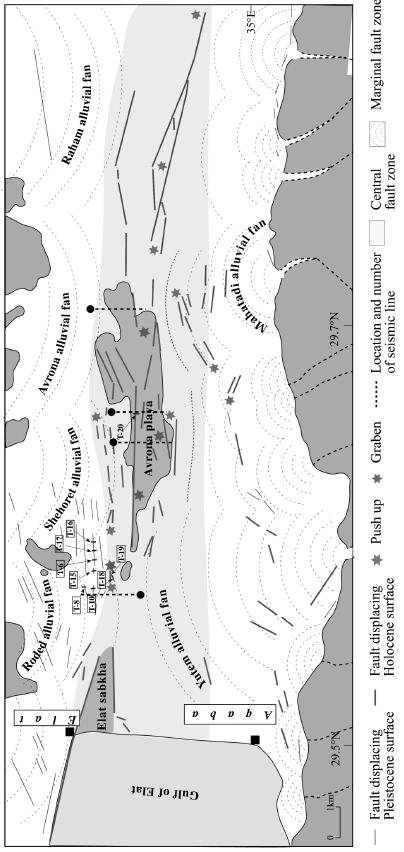
 Figure 2
Figure 2Map of the southern Arava Valley showing the main morphologic and morphotectonic elements of the southern Arava Valley. Notice marginal and central fault zones, the distribution of the trenches across the selected fault lines, and the location of the seismic lines. Trenches T-6, T-17, and T-16 are located along the same fault line. Amit et al (2002) |
Amit et al (2002) | Figure 2 |
| Aerial photograph locates T-6,T-15-19 |

 Figure 9a
Figure 9aAn aerial photograph of the Shehoret alluvial fan. Most of the trenches discussed in the paper are marked on this photograph. Notice the Holocene alluvial fan (Qa3) crossed by an asymmetrical, north-trending graben structure, marked by arrows. Amit et al (2002) |
Amit et al (2002) | Figure 9a |
| Aerial photograph locates T-20,21,22 |

 Figure 3
Figure 3Air photo of the Avrona playa showing the traces of the photogrametric topographic profiles (circles) and the sites of the trenches and exposures (rectangles) described in the text. The straight lineament that bounds and crosses the playa (dark area)represents a NNE-trending fault of the Avrona Shear Zone. This fault is trenched in T-20. The dark area bounded by straight lineaments corresponds to the uplifted sterile playa sediment. The light-tone areas mark the wide braided Wadi Avrona stream, which occupies a structural depression in the north and splits into several narrow and shallow streams within the playa area. The main faults are designated A–E; the profiles are labelled GI-0061, GI-0065 andGI-0074. Zilberman et al (2005) |
Zilberman et al (2005) | Figure 3 |
| Geomorphic Map of the southern Arava |

 Figure 2
Figure 2Geomorphic map of the southern Arava valley in the Avrona basin. Zilberman et al (2005) |
Zilberman et al (2005) | Figure 2 |
| Geologic Map of the southern Arava |

 Figure 1
Figure 1Location Map of the study area. Zilberman et al (2005) |
Zilberman et al (2005) | Figure 1 |
| Summary of Tectonic Events |

 Table 2
Table 2Elat Fault Zone Data Amit et al (2002) |
Amit et al (2002) | Table 1 |
| T-6 Trench Log |

 Figure 4
Figure 4Log of the southern wall of trench T-6 across one of the faults that crosses the marginal fault zone. The location of trench T-6 is shown in Figures 2 and 9A. Amit et al (2002) |
Amit et al (2002) | Figure 4 |
| T-17 Trench Log |

 Figure 5
Figure 5Log of the southern wall of trench T-17, 100 m north of trench T-6 across the same fault line. The location of trench T-17 is shown in Figures 2 and 9A. Amit et al (2002) |
Amit et al (2002) | Figure 5 |
| T-18 Trench Log |

 Figure 8
Figure 8Log of the southern wall of trench T-18, showing a graben structure located in the central fault zone. Boxes show detail of areas adjacent to faults. The location of trench T-18 is shown in Figures 2 and 9A. Amit et al (2002) |
Amit et al (2002) | Figure 8 |
| T-19 Trench Log |

 Figure 9b
Figure 9bLog of the southern wall of trench T-19, located in an active stream bed at the northern tip of the graben. Amit et al (2002) |
Amit et al (2002) | Figure 9b |
| T-19 Trench Log Legend |
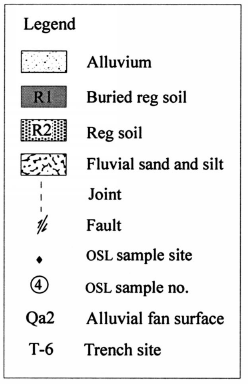
 Figure 9b Legend
Figure 9b Legend
Amit et al (2002) |
Amit et al (2002) | Figure 9b Legend |
| T-20 Trench Log |

 Figure 10
Figure 10Log of the southern wall of trench T-20, across a fault scarp in the Avrona playa. The location of trench T-20 is shown in Figure 2. Amit et al (2002) |
Amit et al (2002) | Figure 10 |
| Dating Chart - Geography |
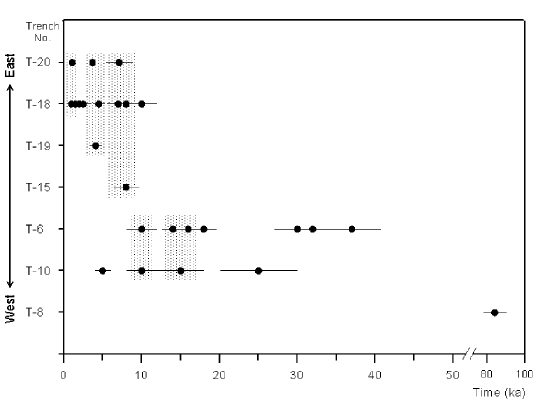
 Figure 6
Figure 6Earthquake distribution in time and space across the Elat fault zone. The y-axis shows the trenches studied; they are plotted top to bottom from east to west. The black dots mark identified and dated events detected along the main fault plane exposed in each trench. The x-axis shows the time of the tectonic event. An error bar indicating the dating uncertainties is attached to each dot. The shaded rectangles indicate possibly correlative earthquakes; these are interpreted to have occurred simultaneously on different branches of the Elat fault zone (except for trenches T-6 and T-17, which are located on the same fault line 100 m apart from each other). Amit et al (2002) |
Amit et al (2002) | Figure 6 |
| Dating Chart - Displacement |

 Figure 7
Figure 7Variation with time of the displacement along the Elat fault zone. The black bars attached to each symbol mark the error in the determination of the age of the seismic event. Amit et al (2002) |
Amit et al (2002) | Figure 7 |
| Dating Chart - Magnitude |
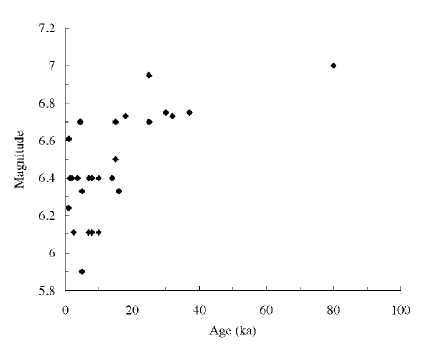
 Figure 11
Figure 11Temporal distribution of earthquake magnitudes on the Elat fault zone. Two clusters of earthquake magnitudes were detected. One cluster represents the past 20 k.y., during which the maximum magnitude was M 6.7. A second cluster represents a time range from 80 to 20 ka during which the maximum magnitude was M 7.1. Amit et al (2002) |
Amit et al (2002) | Figure 11 |
| Dating Chart |
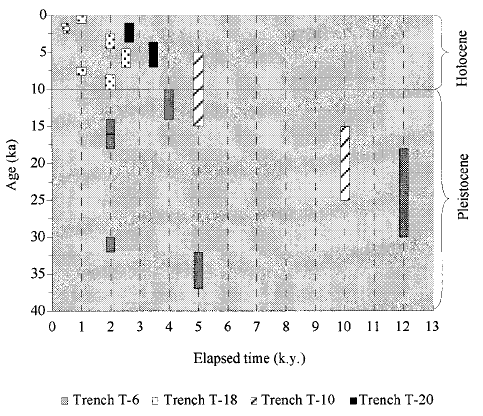
 Figure 12
Figure 12Time elapsed between tectonic events over the past 40 k.y. across the Elat fault zone. The length of each bar reflects the length of time between two successive events. Amit et al (2002) |
Amit et al (2002) | Figure 12 |
| Dating Chart - Geography |

 Figure 13
Figure 13Time and space diagram of earthquakes with magnitudes larger than M 6.5. The location of the large events migrates with time over the fault zone. Each trench represents a separate fault branch. The black lines reflect the time of each tectonic event, and the box length reflects the time error. Amit et al (2002) |
Amit et al (2002) | Figure 13 |
| Composite topographic profiles of Wadi Avrona |

 Figure 6
Figure 6Composite topographic profiles of the Wadi Avrona stream-channel and the elevated sub-ridges across the playa area. Notice the nick-point at I, where the stream crosses the fault that displaces the alluvial fan, and the convex profile of the stream channel between points II and III, where the stream crosses the elevated ridge. Numbers refer to segments of the photogrametric profiles. The soil and sedimentary profiles represent the upper 1.5 m of the elevated playa deposits, showing similarity throughout the tectonically deformed area.Notice the petrosalic horizon, which serves as a chrono-stratigraphic marker for correlating the elevated playa surface. Zilberman et al (2005) |
Zilberman et al (2005) | Figure 6 |
| Water canal in the Avrona Islamic farm |
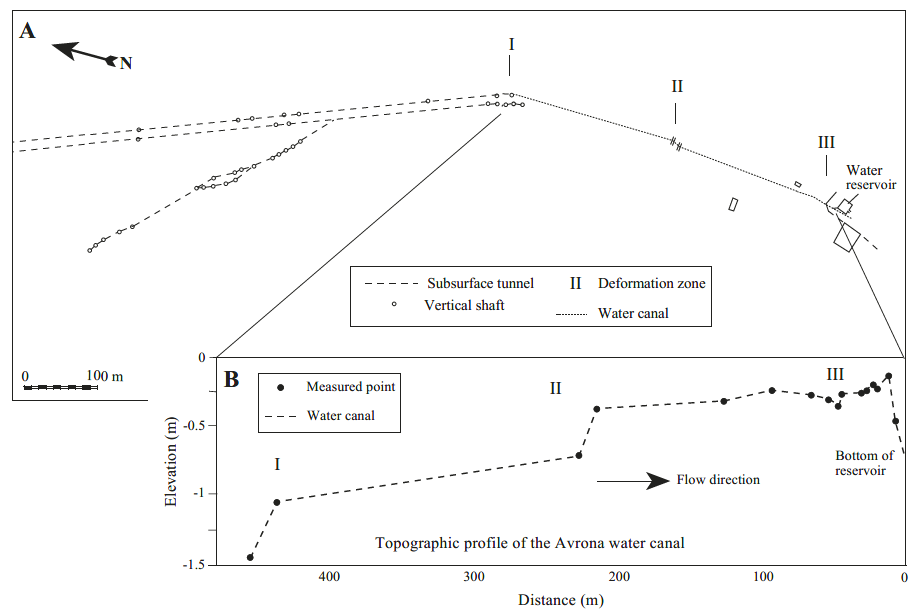
 Figure 7
Figure 7Topographic profile of the water canal in the Avrona Islamic farm. The profiles were measured by EDM total station. Zilberman et al (2005) |
Zilberman et al (2005) | Figure 7 |